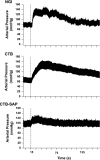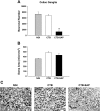Targeted ablation of mesenteric projecting sympathetic neurons reduces the hemodynamic response to pain in conscious, spinal cord-transected rats
- PMID: 20219868
- PMCID: PMC2867526
- DOI: 10.1152/ajpregu.00755.2009
Targeted ablation of mesenteric projecting sympathetic neurons reduces the hemodynamic response to pain in conscious, spinal cord-transected rats
Abstract
Individuals with spinal cord injuries above thoracic level 6 (T(6)) experience episodic bouts of life-threatening hypertension as part of a condition termed autonomic dysreflexia. The paroxysmal hypertension can be caused by a painful stimulus below the level of the injury. Targeted ablation of mesenteric projecting sympathetic neurons may reduce the severity of autonomic dysreflexia by reducing sympathetic activity. Therefore, cholera toxin B subunit (CTB) conjugated to saporin (SAP; a ribosomal inactivating protein that binds to and inactivates ribosomes) was injected into the celiac ganglion to test the hypothesis that targeted ablation of mesenteric projecting sympathetic neurons reduces the pressor response to pain in conscious, spinal cord-transected rats. Nine Sprague-Dawley male rats underwent a spinal cord transection between thoracic vertebrae 4 and 5. Following recovery (5 wk), all rats were instrumented with a radio telemetry device for recording arterial pressure and bilateral catheters in the gluteus maximus muscles for the infusion of hypertonic saline (hNa(+)Cl(-)). Subsequently, the hemodynamic responses to intramuscular injection of hNa(+)Cl(-) (100 microl and 250 microl, in random order) were determined. Following the experiments in the no celiac ganglia injected condition (NGI), rats received injections of CTB-SAP (n = 5) or CTB (n = 3) into the celiac ganglia. CTB-SAP rats, compared with NGI and CTB rats, had reduced pressor responses to hNa(+)Cl(-). Furthermore, the number of stained neurons in the celiac ganglia and spinal cord (segments T(6)-T(12)), was reduced in CTB-SAP rats. Thus, CTB-SAP retrogradely transported from the celiac ganglia is effective at ablating mesenteric projecting sympathetic neurons and reducing the pressor response to pain in spinal cord-transected rats.
Figures





Similar articles
-
Targeted ablation of cardiac sympathetic neurons reduces resting, reflex and exercise-induced sympathetic activation in conscious rats.Am J Physiol Heart Circ Physiol. 2009 May;296(5):H1305-11. doi: 10.1152/ajpheart.00095.2009. Epub 2009 Mar 20. Am J Physiol Heart Circ Physiol. 2009. PMID: 19304949 Free PMC article.
-
Targeted ablation of cardiac sympathetic neurons reduces the susceptibility to ischemia-induced sustained ventricular tachycardia in conscious rats.Am J Physiol Heart Circ Physiol. 2010 May;298(5):H1330-9. doi: 10.1152/ajpheart.00955.2009. Epub 2010 Feb 19. Am J Physiol Heart Circ Physiol. 2010. PMID: 20173045 Free PMC article.
-
Intraspinal sprouting of unmyelinated pelvic afferents after complete spinal cord injury is correlated with autonomic dysreflexia induced by visceral pain.Neuroscience. 2009 Mar 3;159(1):369-79. doi: 10.1016/j.neuroscience.2008.12.022. Epub 2008 Dec 24. Neuroscience. 2009. PMID: 19146928 Free PMC article.
-
Segmental organization of spinal reflexes mediating autonomic dysreflexia after spinal cord injury.Prog Brain Res. 2006;152:265-74. doi: 10.1016/S0079-6123(05)52017-X. Prog Brain Res. 2006. PMID: 16198706 Free PMC article. Review.
-
Orthostatic hypotension and paroxysmal hypertension in humans with high spinal cord injury.Prog Brain Res. 2006;152:231-43. doi: 10.1016/S0079-6123(05)52015-6. Prog Brain Res. 2006. PMID: 16198704 Review.
Cited by
-
Direct comparison of cervical and high thoracic spinal cord injury reveals distinct autonomic and cardiovascular consequences.J Appl Physiol (1985). 2020 Mar 1;128(3):554-564. doi: 10.1152/japplphysiol.00721.2019. Epub 2020 Jan 30. J Appl Physiol (1985). 2020. PMID: 31999525 Free PMC article.
-
Phrenic long-term facilitation following intrapleural CTB-SAP-induced respiratory motor neuron death.Respir Physiol Neurobiol. 2018 Oct;256:43-49. doi: 10.1016/j.resp.2017.08.003. Epub 2017 Aug 16. Respir Physiol Neurobiol. 2018. PMID: 28822818 Free PMC article.
-
Spinal cord injury increases the reactivity of rat tail artery to angiotensin II.Front Neurosci. 2015 Jan 6;8:435. doi: 10.3389/fnins.2014.00435. eCollection 2014. Front Neurosci. 2015. PMID: 25610365 Free PMC article.
-
Tongue and hypoglossal morphology after intralingual cholera toxin B-saporin injection.Muscle Nerve. 2021 Mar;63(3):413-420. doi: 10.1002/mus.27131. Epub 2020 Dec 15. Muscle Nerve. 2021. PMID: 33269488 Free PMC article.
-
Tongue exercise ameliorates structural and functional upper airway deficits in a rodent model of hypoglossal motor neuron loss.Front Neurol. 2024 Sep 4;15:1441529. doi: 10.3389/fneur.2024.1441529. eCollection 2024. Front Neurol. 2024. PMID: 39296960 Free PMC article.
References
-
- Behnia R, Koushanpour E, Sinclair DM. Pressure-heart rate relationship in intact and after stepwise elimination of three major baroreflex loops in dogs. Anesth Analg 83: 965–974, 1996 - PubMed
-
- Bolognesi A, Tazzari PL, Olivieri F, Polito L, Falini B, Stirpe F. Induction of apoptosis by ribosome-inactivating proteins and related immunotoxins. Int J Cancer 68: 349–355, 1996 - PubMed
-
- Capra NF, Ro JY. Experimental muscle pain produces central modulation of proprioceptive signals arising from jaw muscle spindles. Pain 86: 151–162, 2000 - PubMed
-
- Chen Y, Chandler MP, DiCarlo SE. Acute exercise attenuates cardiac autonomic regulation in hypertensive rats. Hypertension 26: 676–683, 1995 - PubMed
-
- Ciriello J, Hrycyshyn AW, Calaresu FR. Horseradish peroxidase study of brain stem projections of carotid sinus and aortic depressor nerves in the cat. J Auton Nerv Syst 4: 43–61, 1981 - PubMed
Publication types
MeSH terms
Substances
Grants and funding
LinkOut - more resources
Full Text Sources
Other Literature Sources
Medical
Miscellaneous

